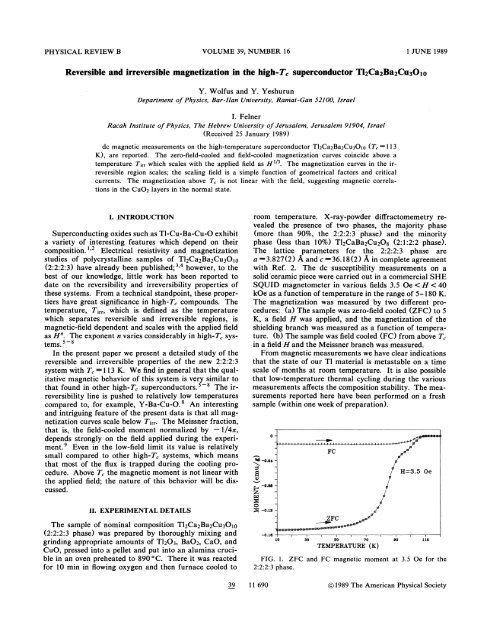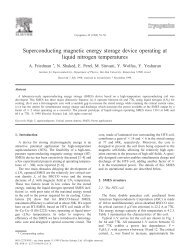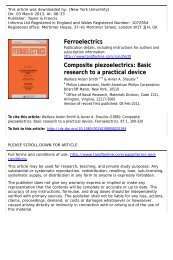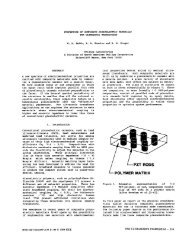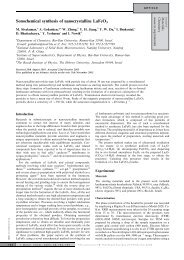Reversible and irreversible magnetization in the high-T_{c ...
Reversible and irreversible magnetization in the high-T_{c ...
Reversible and irreversible magnetization in the high-T_{c ...
You also want an ePaper? Increase the reach of your titles
YUMPU automatically turns print PDFs into web optimized ePapers that Google loves.
PHYSICAL REVIEW B VOLUME 39, NUMBER 16 1 JUNE 1989<strong>Reversible</strong> <strong>and</strong> <strong>irreversible</strong> <strong>magnetization</strong> <strong>in</strong> <strong>the</strong> <strong>high</strong>-T, superconductor Tl2ca2Ba2Cu301pY. Wolfus <strong>and</strong> Y. YeshurunDepartment of Physics, Bar Ilan-University, Ramat Gan -52100, IsraelI. Fe<strong>in</strong>erRacah Institute of Physics, The Hebrew University of Jerusalem, Jerusalem 91904, Israel(Received 25 January 1989)dc magnetic measurements on <strong>the</strong> <strong>high</strong>-temperature superconductor TlqCa28aiCu30io (T, =113K), are reported. The zero-field-cooled <strong>and</strong> field-cooled <strong>magnetization</strong> curves co<strong>in</strong>cide above atemperature T;„which scales with <strong>the</strong> applied field as 0' . The <strong>magnetization</strong> curves <strong>in</strong> <strong>the</strong> <strong>irreversible</strong>region scales; <strong>the</strong> scal<strong>in</strong>g field is a simple function of geometrical factors <strong>and</strong> criticalcurrents. The <strong>magnetization</strong> above T, is not l<strong>in</strong>ear with <strong>the</strong> field, suggest<strong>in</strong>g magnetic correlations<strong>in</strong> <strong>the</strong> Cu02 layers <strong>in</strong> <strong>the</strong> normal state.Superconduct<strong>in</strong>gI. , INTRODUCTIONoxides such as Tl-Cu-Ba-Cu-0 exhibita variety of <strong>in</strong>terest<strong>in</strong>g features which depend on <strong>the</strong>ircomposition. ' Electrical resistivity <strong>and</strong> <strong>magnetization</strong>studies of polycrystall<strong>in</strong>e samples of T12CazBa2Cu30io(2:2:2:3)have already been published;3 however, to <strong>the</strong>best of our knowledge, little work has been reported todate on <strong>the</strong> reversibility <strong>and</strong> irreversibility properties of<strong>the</strong>se systems. From a technical st<strong>and</strong>po<strong>in</strong>t, <strong>the</strong>se propertiershave great significance <strong>in</strong> <strong>high</strong>-T, compounds. Thetemperature, T;„, which is def<strong>in</strong>ed as <strong>the</strong> temperaturewhich separates reversible <strong>and</strong> <strong>irreversible</strong> regions, ismagnetic-field dependent <strong>and</strong> scales with <strong>the</strong> applied fieldas 0". The exponent n varies considerably <strong>in</strong> <strong>high</strong>-T, systems.In <strong>the</strong> present paper we present a detailed study of <strong>the</strong>reversible <strong>and</strong> <strong>irreversible</strong> properties of <strong>the</strong> new 2:2:2:3system with T, =113K. %'e f<strong>in</strong>d <strong>in</strong> general that <strong>the</strong> qualitativemagnetic behavior of this system is very similar tothat found <strong>in</strong> o<strong>the</strong>r <strong>high</strong>-T, superconductors. The irreversibilityl<strong>in</strong>e is pushed to relatively low temperaturescompared to, for example, Y-Ba-Cu-O. An <strong>in</strong>terest<strong>in</strong>g<strong>and</strong> <strong>in</strong>trigu<strong>in</strong>g feature of <strong>the</strong> present data is that all <strong>magnetization</strong>curves scale below T;„. The Meissner fraction,that is, <strong>the</strong> field-cooled moment normalized by — I/4tr,depends strongly on <strong>the</strong> field applied dur<strong>in</strong>g <strong>the</strong> experiment.Even <strong>in</strong> <strong>the</strong> low-field limit its value is relativelysmall compared to o<strong>the</strong>r <strong>high</strong>-T, systems, which meansthat most of <strong>the</strong> fiux is trapped dur<strong>in</strong>g <strong>the</strong> cool<strong>in</strong>g procedure.Above T, <strong>the</strong> magnetic moment is not l<strong>in</strong>ear with<strong>the</strong> applied field; <strong>the</strong> nature of this behavior will be discussed.II. EXPERIMENTAL DETAILSThe sample of nom<strong>in</strong>al composition T12Ca28a2Cu30)0(2:2:2:3 phase) was prepared by thoroughly mix<strong>in</strong>g <strong>and</strong>gr<strong>in</strong>d<strong>in</strong>g appropriate amounts of T1203, Ba02, CaO, <strong>and</strong>CuO, pressed <strong>in</strong>to a pellet <strong>and</strong> put <strong>in</strong>to an alum<strong>in</strong>a crucible<strong>in</strong> an oven preheated to 890 C. There it was reactedfor 10 m<strong>in</strong> <strong>in</strong> flow<strong>in</strong>g oxygen <strong>and</strong> <strong>the</strong>n furnace cooled toroom temperature. X-ray-powder diffractomemetry revealed<strong>the</strong> presence of two phases, <strong>the</strong> majority phase(more than 90%, <strong>the</strong> 2:2:2:3 phase) <strong>and</strong> <strong>the</strong> m<strong>in</strong>orityphase (less than 10%) T12CaBazCu20s (2:1:2:2phase).The lattice parameters for <strong>the</strong> 2:2:2:3 phase area 3.827(2) A <strong>and</strong> c -36.18(2) A <strong>in</strong> complete agreementwith Ref. 2. The dc susceptibility measurements on asolid ceramic piece were carried out <strong>in</strong> a commercialSHESQUID magnetometer <strong>in</strong> various fields 3.5 Oe (H (40kOe as a function of temperature <strong>in</strong> <strong>the</strong> range of 5-180 K.The <strong>magnetization</strong> was measured by two diff'erent procedures:(a) The sample was zero-field cooled (ZFC) to 5K, a field H was applied, <strong>and</strong> <strong>the</strong> <strong>magnetization</strong> of <strong>the</strong>shield<strong>in</strong>g branch was measured as a function of temperature.(b) The sample was field cooled (FC) from above T,<strong>in</strong> a field H <strong>and</strong> <strong>the</strong> Meissner branch was measured.From magnetic measurements we have clear <strong>in</strong>dicationsthat <strong>the</strong> state of our Tl material is metastable on a timescale of months at room temperature. It is also possiblethat low-temperature <strong>the</strong>rmal cycl<strong>in</strong>g dur<strong>in</strong>g <strong>the</strong> variousmeasurements affects <strong>the</strong> composition stability. The measurementsreported here have been performed on a freshsample (with<strong>in</strong> one week of preparation).~ -o.oaC4-0.06OQ -0.1S-O.ia10I I I50 70TEMPERATURE (K)90 110FIG. 1. ZFC <strong>and</strong> FC magnetic moment at 3.5 Oe for <strong>the</strong>2:2:2:3phase.39 11 690 1989 The American Physical Society
39 REVERSIBLE AND IRREVERSIBLE MAGNETIZATION IN THE. . . 11 6930Q 1 JI4.5-0.2 —,-0.8COg -04-0.5-Q.e0X-07 — +X-0.8— O0-0.9—h0TEMP(K)v+ RQO $0+ 400 5Q8070OICD43.510H/HmaxFIG. 7. Scal<strong>in</strong>g of several magnetic curves at diA'erent temperatures(see text).3 1101 I l130 150TEMPERATURE (K)1170FIG. 8. Temperature dependence of magnetic susceptibilitymeasured at various fields above T,. In <strong>the</strong> <strong>in</strong>set: The variationof <strong>the</strong> susceptibility with <strong>the</strong> applied field is shown.where r 10 cm is <strong>the</strong> average radius of a gra<strong>in</strong>; <strong>the</strong>density is 3 g/cm . J, has an error of 20% due to <strong>the</strong> uncerta<strong>in</strong>tyof r.Qualitatively, very similar curves to Fig. 6 are obta<strong>in</strong>edat various temperatures, allow<strong>in</strong>g us to scale all <strong>the</strong> <strong>magnetization</strong>curves us<strong>in</strong>g a simple procedure. %'e scale <strong>the</strong>field axis with H, „, <strong>the</strong> field for which M reaches itsmaximum value M,„; similarly, we scale <strong>the</strong> M axis withMm, „. The result of this scal<strong>in</strong>g for several temperaturesis exhibited <strong>in</strong> Fig. 7. Perfect scal<strong>in</strong>g is obta<strong>in</strong>ed for fields<strong>and</strong> temperatures <strong>in</strong> <strong>the</strong> <strong>irreversible</strong> regions. Clear deviationsfrom scal<strong>in</strong>g are observed for fields <strong>and</strong> temperatures<strong>in</strong> <strong>the</strong> reversible range above <strong>the</strong> irreversibility l<strong>in</strong>e of Fig.5. A complete description of this phenomenon will bepublished elsewhere.E. Nonl<strong>in</strong>ear <strong>magnetization</strong> above T,The temperature dependence of <strong>the</strong> normal-state magneticsusceptibility (M/H) for various fields is shown <strong>in</strong>Fig. 8. It is apparent from this figure that <strong>the</strong> <strong>magnetization</strong>does not vary l<strong>in</strong>early with H. The field dependenceof <strong>the</strong> susceptibility at 170 K is given <strong>in</strong> <strong>the</strong> <strong>in</strong>set. Thenonl<strong>in</strong>ear behavior exists up to 40 kOe, <strong>the</strong> <strong>high</strong>est fieldused. M/H depends strongly on temperature <strong>in</strong> contrastto that of s<strong>in</strong>gle-phase Y-Ba-Cu-O. '6 Each of <strong>the</strong> curves<strong>in</strong> Fig. 8 can be fitted by a Curie-Weiss law plus a constantterm, i.e., M/H(T) go+ C/(T — 6). For example,for H 1 <strong>and</strong> 2.5 kOe, go 2.3x10 <strong>and</strong> 4.7x10emu/mole, C 0.59 <strong>and</strong> 0.63 emu/mole, <strong>and</strong> 8 11 <strong>and</strong>— 16 K, respectively. In general, go depends strongly on<strong>the</strong> applied field. It decreases by more than an order ofmagnitude over <strong>the</strong> magnetic-field regime of <strong>the</strong> presentstudy, while <strong>the</strong> Curie constant <strong>in</strong>creases slightly withfield. Similar field effects were also observed <strong>in</strong> Y-Ba-Cu-O. s From <strong>the</strong> above values of <strong>the</strong> Curie constants wederive P,ff 1.26pg (Cu atom) which corresponds to afraction of 73% sp<strong>in</strong>- 2 local moments of <strong>the</strong> Cu + ions(1.71ps). It means that <strong>the</strong> Curie-Weiss contribution to<strong>the</strong> susceptibility is <strong>in</strong>tr<strong>in</strong>sic to <strong>the</strong> (2:2:2:3)s<strong>in</strong>gle phase,<strong>and</strong> does not arise from impurity phases, s<strong>in</strong>ce such alarge concentration of an impurity phase would be easilyvisible <strong>in</strong> <strong>the</strong> x-ray-diffraction pattern.It would be edify<strong>in</strong>g to discover <strong>the</strong> source of <strong>the</strong> nonl<strong>in</strong>ear<strong>magnetization</strong> behavior exhibited <strong>in</strong> Fig. 8. The existenceof ferromagnetic impurities is excluded for <strong>the</strong> follow<strong>in</strong>greasons: (i) The nonl<strong>in</strong>ear behavior cont<strong>in</strong>ues atleast up to 40 kOe (not shown <strong>in</strong> Fig. 8) <strong>and</strong> to relatively<strong>high</strong> temperatures -300 K. No exist<strong>in</strong>g ferromagneticco~pound with such a <strong>high</strong> Curie temperature which isnot saturated at low temperatures at 40 kOe. (ii) To <strong>the</strong>best of our knowledge, <strong>the</strong>re is no compound conta<strong>in</strong><strong>in</strong>gsome of all <strong>the</strong> elements that constitute <strong>the</strong> 2:2:2:3phasewhich is ferromagnetically ordered at about 300 K. We'may assume that as <strong>in</strong> La2Cu04, magnetic correlations<strong>in</strong> <strong>the</strong> Cu02 layers persist <strong>in</strong> <strong>the</strong> compound well above T,;<strong>the</strong>ir nature is now be<strong>in</strong>g studied.ACKNO%"LEDGMENTSThis research is supported by <strong>the</strong> German-Israel Foundationfor Scientific Research <strong>and</strong> Development GrantNo. I-40-100.10/87.'S. S. Park<strong>in</strong>, V. Y. Lee, E. M. Engler, A. I. Nazzal, T. C.Huang, G. Gorman, R. Savoy, <strong>and</strong> R. Beyers, Phys. Rev.Lett. 60, 2539 (1988),2S. S. Park<strong>in</strong>, V. Y. Lee, A. I. Nazzal, R. Savoy, T. C. Huang,G. Gorman, <strong>and</strong> R. Beyers, Phys. Rev. 38, 6531 (1988).W. Reith, P. Muller, C. Allgeier, R. Hoben, J. Heise, J. S. Shill<strong>in</strong>g,<strong>and</strong> K. Andres, Physica C 156, 319 (1988).4M. M. Fang, J. E. Ostenson, J. K. F<strong>in</strong>nemore, D. E. Farrell,<strong>and</strong> N. P. Bansal, Phys. Rev. B 39, 222 (1989).5K. A. Muller, M. Takashige, <strong>and</strong> J. G. Bednorz, Phys. Rev.


